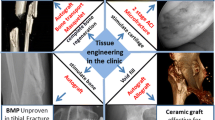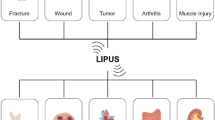Abstract
Angiogenesis is a fundamental process which is essential to the healing of tissues including bone. Sadat–Habdan mesenchymal stimulating peptide (SHMSP) was found to enhance fracture healing. Our goal was to determine whether SHMSP has any effect on angiogenesis. A complete osteotomy of the midulna was created in 20 male, skeletally mature rabbits. In 10 rabbits at the osteotomy site 3.5 mg/kg body weight of the SHMSP was added after irrigation. The control group had only irrigation after the osteotomy was created. Postoperatively both groups received pain relief and were kept in similar circumstances. On fourth and tenth days, five rabbits from each group were sacrificed and the forelimbs were removed and sent for histopathologic examination. At four days, only the treated group showed excessive new vessel growth compared with the control groups at a ratio of 3:1 per field. The picture of neovasculization was clearer with immunochemistry staining with CD31. By the tenth day, the picture of vascularization was marginally better in the treated group and was similar to that seen on fourth day. This preliminary study shows that SHMSP has the potential for stimulating angiogenesis in a fracture module. Further studies are needed to assess its effect in other vascular insufficiencies.










Similar content being viewed by others
References
Ausprunk DH, Folkman J (1977) Migration and proliferation of endothelial cells in preformed and newly formed blood vessels during tumor angiogenesis. Microvasc Res 14:53–65
Ferrara N, (1999) Role of vascular endothelial growth factor hi regulation of angiogenesis. Kidney Int 6:794–814
Henry TD, Annex BH, McKendall GR, Azrin MA, et al. (2003) The VIVA trial: Vascular endothelial growth factor in Ischemia for Vascular Angiogenesis. Circulation 107(10):1357–1365
Hershey JC, Baskin EP, Corcoran HA, Bett A, Dougherty NM, Gilberto DB, Mao X, Thomas KA, Cook JJ (2003) Vascular endothelial growth factor stimulates angiogenesis without improving collateral blood flow following hind limb ischemia in rabbits. Heart vessels 18(3):142–149
Keck PJ, Hauser SD, Krivi G, Sanzo K, Warren T, Feder J, Connolly DT (1989) Vascular permeability factor, an endothelial cell mitogen related to PDGF. Science 246:1309–1312
Leung DW, Cachianes G, Kuang WJ, Goeddel DV, Ferrara N (1989) Vascular endothelial growth factor is a secreted angiogenic mitogen. Science 246:1306–1309
Cavdias AX, Trueta J (1965) An experimental study of the vascular contribution to the callus of fracture. Surg Gynecol Obstet 120:731–747
Kelly PJ, Montgomery RJ, Bronk JT (1990) Reaction of the circulatory system to injury and regeneration. Clin Orthop 254:275–288
Rhinelander FW (1968) The normal microcirculation of diaphyseal cortex and its response to fracture. J Bone Joint Surg 50A:784–800
Phillips GD, Whitehead RA, Stone AM, Ruebel MW, Goodk ML, Knighton DR (1993) Transforming growth factor β (TGF-β) stimulation of angiogenesis an electron microscopic study. J Submicrosc Cytol Pathol 25:149–155
Wang JS (1996) Basic fibroblast growth factor for stimulation of bone formation in osteoinductive or conductive implants. Acta Orthop Scand 269(Supp1):1–33
Wang JS, Aspenberg P (1996) Basic fibroblast growth factor promotes bone ingrowth in porous hydroxyapatite. Clin Orthop 333:252–260
Sadat-Ali M, Al Habdan I (2003) Enhancement of fracture healing by a new peptide. A preliminary report presented at European Orthopaedic Research Society, Helsinki, Finland, 156 [abstr]
Bettmann OL (ed) (1979) J Hunter: Giant of Experimental Surgery. In: A pictoral history of medicine, 5th ed. Springfield, IL: Charles C Thomas, pp 210–213
Urist M (1965) Bone formation by autoinduction. Science 150:893–899
Cook SD (1999) Preclinical and clinical evaluation of Osteogenic protein-1 (BMP-7) in bony sites. Orthopedics 22(7):669–671
Govender S, Csimma C, Genant HK, Valentin-Opran A, Amit Y, et al. (2002) Recombuiant human bone morphogenetic protein-2 for treatment of open tibial fractures: a prospective, controlled, randomized study of four hundred and fifty patients. J Bone Joint Surg Am 84-A(12):2123–2134
Shimmin A, Ruff S (1999) Clinical use of recombinant human osteoaenic protein-1. Bone 24: 409–431
Walker DH, Wright NM (2002) Bone morphogenetic proteins and spinal fusion. Neurosurg Focus 13(6):1–13
Heldin C-H, Miyazono K, ten Dijje P (1997) TGF-β signaling from cell membrane to nucleus via Smad proteins. Nature 390:465–471
Massague J (1998) TGF-β signal transduction. Annu Rev Biochem 67:753–791
Streeten EA, Brandi ML (1990) Biology of bone endothelial cells. Bone Miner 10:85–94
Hausman MR, Schaffler MB, Majeska RJ (2001) Prevention of fracture healing in rats by an inhibitor of angiogenesis. Bone 29(6):560–564
Beck LS, Amento EP, Xu Y, Deguzman L, Lee WP, Nguyen T, Gillett NA (1993) TGF-beta 1 induces bone closure of skull defects: temporal dynamics of bone formation in defects exposed to rh TGF-beta 1. J Bone Miner Res. 8:753–761
Joyce ME, Jingushi S, Bolander ME (1990) Transforming growth factor-beta in the regulation of fracture repair. Orthop Clin North Am 21:199–209
Lind M, Schumacker B, Soballe K, Keller J, Melsen F, Bunger C (1993) Transforming growth factor-beta enhances fracture healing in rabbit tibiae. Acta Ortho Scan 64:553–556
Robey PG, Young MF, Flanders KC, Roche NS, Kondaiah P, Reddi AH, Termine JD, Sporn MB, Roberts AB (1987) Osteoblasts synthesize and respond to transforming growth factor-type beta (TGF-beta) in vitro. J Cell Biol 106:457–463
Sandberg MM, Aro HT, Vuorio EI (1993) Gene expression during fracture repair. Clin Orthop 289:292–312
Hockel M, Burke FJ (1989) Angiotropin treatment prevents flap necrosis and enhances dermal regeneration in rabbits. Arch Sura 124:693–698
Takeshita S, Zheng LP, Brogi E, Kearney M, Pu LQ, (1994) Therapeutic angiogenesis. A single intra-arterial bolus of vascular endothelial growth factor augments revascularization in a rabbit ischemic hind limb model. J Clin Invest 93:662–670
Griffioen AW, Molema G (2000) Angiogenesis: Potentials for pharmacologic intervention in the treatment of cancer, cardiovascular diseases and chronic inflammation. Pharmacol Rev 52:237–268
Lazarous DF, Scheinowitz M, Shou M, Hodge E, Rajanayagam S, Hunsberger S, Robison WG Jr, Stiber JA, Correa R, Epstein SE, et al. (1995) Effect of chronic systemic administration of basic fibroblast growth factor on collateral development in the canine heart. Circulation 91:145–153
Unger EF, Banai S, Shou M, Lazarous DP, Jaklitsch MT, Scheinowitz M, Correa R, Klingbeilc, Epstein S (1994) Basic flbroblast growth factor enhances myocardial collateral flow in canine model. Am J Physiol 266:1588–1595
Rajanayagam MA, Shou M, Thirumurti V, Lazarous DF, Quyyumi AA, Goncalves L, Stiber J, Epstein SE, Unger EF (2000) Intracoronary basic fibroblast growth factor enhances myocardial collateral perfusions in dogs. J Am Coll Cardiol 35(2):519–526
Author information
Authors and Affiliations
Corresponding author
About this article
Cite this article
Sadat-Ali, M., Al-Habdan, I. & Shawarby, M.A. Angiogenesis: A New Factor on the Block —A Preliminary Observation. Int J Angiol 14, 87–91 (2005). https://doi.org/10.1007/s00547-005-2010-5
Issue Date:
DOI: https://doi.org/10.1007/s00547-005-2010-5




